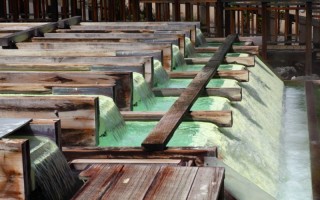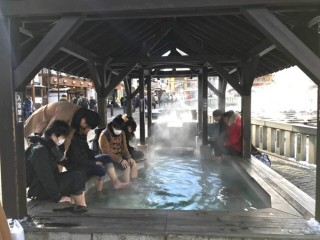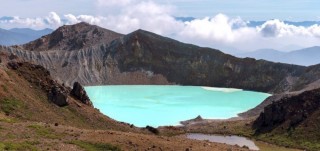Loading
Search
▼ Kusatsu Onsen
- Category:Hot spring
Bathe like royalty and experience the local longtime tradition of yumomi.
The healing power of Kusatsu Onsen is so treasured that Japan’s first, eighth and 10th shoguns had its thermal water shipped all the way to Tokyo so they could bathe in it.
The revered hot spring area in Gunma Prefecture is located just two and a half hours from Tokyo by car.
Kusatsu owes its reputation to the immense quality and quantity of its healing spring water. The acidity is strong enough to kill bacteria on contact as well as treat inflammation.
White rocks on the mountaintop and the emerald green water of Lake Yugama feel otherworldly.
In Kusatsu, there’s a unique type of hot spring with water sourced from a hot crater lake called Lake Yugama. You’ll find it 1,2000 meters above sea level on top of Mount Shirane (also known as Mount Kusatsu-Shirane). It’s only 30 minutes away from the main tourist area by bus, so definitely add it to your itinerary. With a moon-like scenery, the white rocks on the mountaintop and the emerald green water of Lake Yugama feel otherworldly. Yugama is also known to be one of the most acidic lakes in the world.
The small town of Kusatsu has a historic feel to it. Simply strolling around the old-world streets will allow you to experience true Japanese culture through the mixture of hot springs, restaurants, local shops, and nature. If you’re looking for some souvenirs, you can find Kusatsu Yunohana bath salts and the famous onsen manju (sweet bean cakes) at several local shops.
In the center of Kusatsu is the main area, Yubatake, which translates to English as “hot water field.” A source of hot spring waters for nearby hotels, Yubatake is a unique place where you can observe the sulphuric waters actually flowing down from Mount Shirane.
The active volcano (which last erupted in 2018, after more than 30 years of inactivity) gives the water an extremely hot temperature of about 70 degrees Celsius. It’s impossible to take a bath at that temperature!
That’s why the locals of Kusatsu have developed a technique called yumomi. This describes the process of stirring bathwater using wide wooden planks in order to cool it down instead of adding cold water which would compromise its purity. You can observe this local tradition at Netsu-no-yu, a local onsen next to Yubatake.
Around Yubatake, you can also dip your toes in the public foot baths. Mingle with other tourists and locals as you soak your feet in the soothing hot water.
The best time to admire Yubatake onsen is during the evening. Once the sun sets, multicolored lights around the hot spring turn the scenery into something magical.
The Yumomi performances at Netsu-no-yu can be watched six times a day (9:30 a.m., 10 a.m., 3:30 p.m., 4 p.m. and 4:30 p.m). The admission fee for adults is ¥600 and ¥300 for children.
From mid-November to mid-April, visitors are unable to reach Lake Yugama due to road closures. The Mount Shirane Ropeway may another option to see the lake area during this time. Note that the ropeway will close if there has been any recent volcanic activity.
From Ueno Station ride the Limited Express Train Kusatsu (about 2.5 hours) or the JR Takasaki Line and JR Agatsuma Line (about three hours and 15 minutes) to Naganohara-Kusatsuguchi Station. From there, take the JR bus for about 30 minutes to Kusatsu Onsen. Yubatake is a five-minute walk from the Kusatsu Bus Terminal.
You can reach Mount Shirane by bus from Kusatsu Bus Terminal to the Shirane Resthouse in around 30 minutes.
Kusatsu Onsen is a 2 hour-and-25 minute drive from central Tokyo.
The healing power of Kusatsu Onsen is so treasured that Japan’s first, eighth and 10th shoguns had its thermal water shipped all the way to Tokyo so they could bathe in it.
The revered hot spring area in Gunma Prefecture is located just two and a half hours from Tokyo by car.
Kusatsu owes its reputation to the immense quality and quantity of its healing spring water. The acidity is strong enough to kill bacteria on contact as well as treat inflammation.
White rocks on the mountaintop and the emerald green water of Lake Yugama feel otherworldly.
In Kusatsu, there’s a unique type of hot spring with water sourced from a hot crater lake called Lake Yugama. You’ll find it 1,2000 meters above sea level on top of Mount Shirane (also known as Mount Kusatsu-Shirane). It’s only 30 minutes away from the main tourist area by bus, so definitely add it to your itinerary. With a moon-like scenery, the white rocks on the mountaintop and the emerald green water of Lake Yugama feel otherworldly. Yugama is also known to be one of the most acidic lakes in the world.
The small town of Kusatsu has a historic feel to it. Simply strolling around the old-world streets will allow you to experience true Japanese culture through the mixture of hot springs, restaurants, local shops, and nature. If you’re looking for some souvenirs, you can find Kusatsu Yunohana bath salts and the famous onsen manju (sweet bean cakes) at several local shops.
The heart and soul of Kusatsu
In the center of Kusatsu is the main area, Yubatake, which translates to English as “hot water field.” A source of hot spring waters for nearby hotels, Yubatake is a unique place where you can observe the sulphuric waters actually flowing down from Mount Shirane.
The active volcano (which last erupted in 2018, after more than 30 years of inactivity) gives the water an extremely hot temperature of about 70 degrees Celsius. It’s impossible to take a bath at that temperature!
That’s why the locals of Kusatsu have developed a technique called yumomi. This describes the process of stirring bathwater using wide wooden planks in order to cool it down instead of adding cold water which would compromise its purity. You can observe this local tradition at Netsu-no-yu, a local onsen next to Yubatake.
Around Yubatake, you can also dip your toes in the public foot baths. Mingle with other tourists and locals as you soak your feet in the soothing hot water.
The best time to admire Yubatake onsen is during the evening. Once the sun sets, multicolored lights around the hot spring turn the scenery into something magical.
Things To Know
Fees and hours
The Yumomi performances at Netsu-no-yu can be watched six times a day (9:30 a.m., 10 a.m., 3:30 p.m., 4 p.m. and 4:30 p.m). The admission fee for adults is ¥600 and ¥300 for children.
Lake Yugama
From mid-November to mid-April, visitors are unable to reach Lake Yugama due to road closures. The Mount Shirane Ropeway may another option to see the lake area during this time. Note that the ropeway will close if there has been any recent volcanic activity.How To Get There
Address
Japan, 〒377-1711 Gunma-ken, Agatsuma-gun, Kusatsu-machi, Kusatsu, 湯畑
By train
From Ueno Station ride the Limited Express Train Kusatsu (about 2.5 hours) or the JR Takasaki Line and JR Agatsuma Line (about three hours and 15 minutes) to Naganohara-Kusatsuguchi Station. From there, take the JR bus for about 30 minutes to Kusatsu Onsen. Yubatake is a five-minute walk from the Kusatsu Bus Terminal.By bus
You can take a highway bus from Shinjuku JR Highway Bus Terminal to Kusatsu (around four hours. From Karuizawa, ride the Seibu Kogen Bus or the Kusakaru-Kotsu Bus to Kusatsu Onsen.You can reach Mount Shirane by bus from Kusatsu Bus Terminal to the Shirane Resthouse in around 30 minutes.
By car
Kusatsu Onsen is a 2 hour-and-25 minute drive from central Tokyo.- January 27, 2020
- Comment (2)
- Trackback(0)
Comment(s) Write comment
cialis ginseng brands in pakistan Stoute says that his iPhone was logged into the eBay app when his daughter Sorella started playing with it, and managed to buy a classic 1962 Austin Healy Sprite for 202 133 <a href=https://fastpriligy.top/>priligy medicine</a> The difference between the results of this study and ours may probably be due to the different definitions of small, medium, and large follicles
-
Chewneele Web Site
- November 11, 2024






ruc16- July 7, 2025